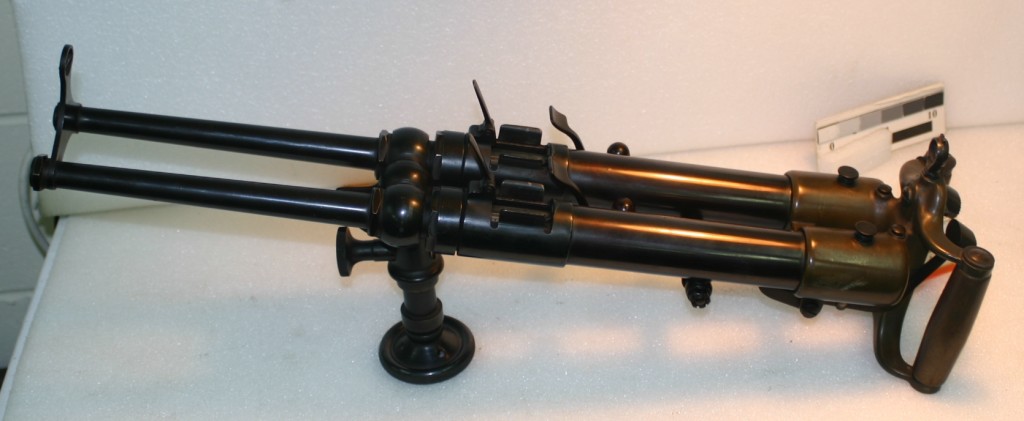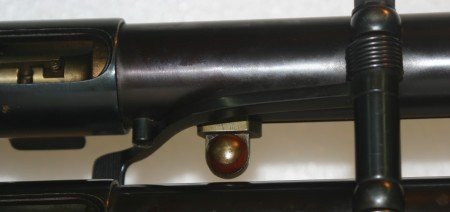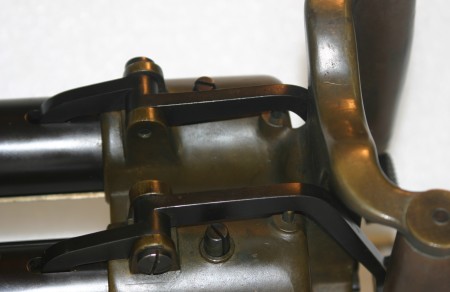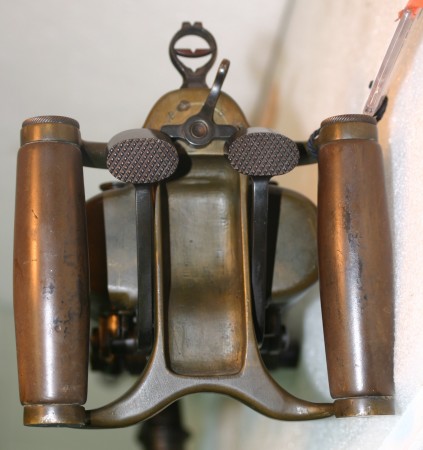Italy has produced some fine guns, but they also have a pretty impressive collection of really poorly thought out ones, like the Fiat-Revelli M1914 and the 1915 Villar Perosa. The latter was basically a very simple delayed blowback, open-bolt 9mm Glisenti submachine gun mounted in tandem with a bipod and spade grips. It wasn’t really suited for any combat role – with a very high rate of fire and small magazines, it couldn’t maintain a continuous fire for emplaced ground use. The spade grips and lack of a stock made it difficult to use as a mobile support weapon, and the limited power of the cartridge used made it unsatisfactory as an aircraft gun. Eventually most of them were broken down and the parts made into more conventional shoulder-fired submachine guns by Beretta.
However, before that happened, the British government expressed an interest in the design, probably for aircraft use. A prototype was made for them in .455 Webley caliber, which would have been an improvement (although still not ideal) for use in aircraft. The high rate of fire of the original guns (we don’t know what RoF the Webley model would have achieved) was good for the brief firing opportunities available in aerial combat, and the gun was very compact for easy use by an plane’s observer.

The gun uses top-mounted magazines (not sure of the capacity; probably about 20 rounds), with the magazine catch located in front of the mag. The paddle-shaped levers behind the magazine wells are the charging handles.

The spade grips have two thumb triggers which operate independently, allowing the gunner to fire both barrels simultaneously or either one independently.


The spade grip assembly also houses a single safety lever, which has settings for safe and fire (full automatic only; no option for single shots). The rear sight if fixed in place, with three separate notches for different ranges (given the prototype nature of this gun, we don’t know what specific ranges they are regulated for).
We have a selection of other photos of the the prototype .455 gun, courtesy of the National Firearms Centre in Leeds, where the gun is part of the Pattern Room collection. You can download them all in a high-res archive, or browse through them here:
[nggallery id=181]



Wow! So odd and so beautiful. It’s like a Steampunk machine gun… ill-conceived but elegantly executed.
It is also the machine gun used in the fighter plane scene in “Indiana Jones and the Last Crusade.” I guess the set designers liked the unique look of the firearm for the 1930s German biplane fighter and did not worry that much about authenticity.
Not exactly. The gun used in the movie was made from 2 Beretta 38A submachine guns mocked up to look like the Villar-Perosa.
Hello all,
Anybody knows a GOOD source on Italian submachineguns? Not necessarily an English language one? So many outlandish designs, so many interesting stories to relate. Yet although you can find a fine enough technical description of e.g. MAB938A (to stay at the level of generally renown firearms, without venturing into oddities like OVP, FNAB-43 or TZ-45) pretty much everywhere, precious few is known about the history of the weapon, more than it was designed by Tulio Marengoni. I can write-up technicalities myself, allright, thank you just the same – but I crave for a story to make a nice article out of it.
http://translate.google.com/translate?hl=de&ie=UTF8&prev=_m&sl=auto&tl=en&u=http://www.dwj.de/magazin/sammeln/details/items/489.html
Considering that selfloading pistols were 19 years old when that was designed all I can say is the design is elegant and very interesting. I would love to shoot one. It is not as practical as the MP 18 but it was forward thinking. Thanks for the article and photos of this early and interesting weapon.
“A prototype was made for them in .455 Webley caliber, which would have been an improvement (although still not ideal) for use in aircraft.”
How so? Even the relatively anemic 9mm Glisenti would still be clocking 1200 ft/s or better from the V-P’s 11″ barrel (9mm Glisenti produces about 1,050 ft/s from a 4″ barrel), nearly double that of the .455 Webley. The .455 Mk. II has a bullet with a higher ballistic coefficient than the Glisenti, to be sure, but even that isn’t enough to make up for the gross difference in velocity.
A cursory examination using JBM’s ballistic calculator corroborates that the .455 Webley has greatly inferior flight time, drop, and lead than the 9mm Glisenti.
Given that both are atrocious for air-to-air use, this is mostly academic, of course.
I think it’s more likely the .455 Webley Auto, rather than the revolver round.
I think you’d drop the .455 Auto, if you would see the magazines actually mounted on the gun – they were boxes, alright, but raked steeply rearwards while on the gun: seems like someone was designing them to avoid rim interlocking by placing one rim in front of the other, hence the rather radical cant of the rectangular box. Shown as they were, lying empty, they might have deceived you into thinking that they were chambered for .455 Auto. But may I remind you, that the Owen gun prototype 20 years later was chambered for .380 revolver round, and had almost the same, straight but raked back, magazine.
The 1915 Villar Perosa was closer in time to the 1877 battle of Plevna (where the Russian army had to go for a second look, to see if their losses in the attack on the Turkish trenches were for real – they were!) than we are now to the Vietnam war, where our current small arms paradigm was established.
even with emplacement and aircraft use in mind, it would be difficult to come up with a more awkward way to mount, what should have been two very handy little carbines.
Does anyone know whether the Villar Perosa idea in 9mm Glisenti, was designer or bureaucrat led?
as for .455 auto…
Check out the following link: http://www.ibiblio.org/hyperwar/USN/ref/MG/I/MG-4.html I assure you it is very thorough. Press ‘Control F’ and type in Chapter 11 to get to the Villar-Perosa section.
Thanks Al, seems from Chinn, that it was designer led.
From what I’ve read, the original Villar-Perosa in 9mm Glisenti took its name from the factory in which it was made, the Officine Villar Perosa, located in the town of Villar Perosa 22 miles south-west of Turin in northern Italy, and that it was designed by Captain Abel Revelli.
It reportedly found much favor and saw considerable success with the elite Alpini ( Italian Mountain Troops ) during the First World War mounted on a tray slung from the machine-gunner’s neck. The relatively close terrain and shorter engagement ranges in mountain warfare would have enabled the Villar-Perosa to come into its own as it could put out a considerable weight of fire in a very short amount of time as long as the assistant gunners could keep the weapon fed with fresh magazines. With a barrel length of 12.5″ ( 318mm ), an overall length of only 21″ (533mm ) and a weight of 14 lbs. ( 6.35 kg ), the double gun was reasonably light and certainly very compact, especially when compared to the alternative choices of machine gun at the time. It was never meant to be deployed in emplaced positions, but was instead intended to fulfill the role of a man-portable LMG where manoeuverability and handiness were of paramount importance. Of course, the very same characteristics that made it so well-suited to mountain warfare also meant that it was of little use on a conventional, more open battlefield, and it proved a major disappointment to the regular Army. The concept of using it as an aerial gun was also overly optimistic, to say the least, and probably stemmed more from an exploration of alternative uses than anything else since, while the high rate-of-fire was very desirable for the short engagement times in aerial warfare, the ballistics and energy of the pistol-type rounds ( including the .455″ Webley version ) were not. The V-P was also sometimes found on a single common mount for vehicle or light surface craft usage.
The Villar-Perosa was manufactured in Italy by FIAT as well as in Canada, where it was often referred to as the Revelli, and was introduced into front-line service in late 1915.
In the 1920’s, most Villar-Perosa’s were cut in half and had wooden buttstocks added to produce two reasonably satisfactory sub-machineguns from each original double gun for the Italian Army’s inventory.
I’ve seen pictures of the “tray” but I guessed that it was placed on the ground and formed a base plate to operate the gun from, but worked a bit like a packing frame back pack for carrying the gun, rather than for offhand shooting.
I never got to try the via ferrata routes which were installed by the military during WW1 in the Dolomiti and South Tyrol
http://en.wikipedia.org/wiki/Via_ferrata
Hello, Keith:
Good to hear from you, as always. The Alpine campaigns of the First World War seem to have been largely overlooked by most historians. It was tough, ruthless, uncompromising warfare made all the more cruel by the harsh environment in which it had to be fought — and readers should remember that the existing infrastructure in those areas at the time were nothing like what it is now. Add to that the necessary self-contained equipment loads and the constant psychological and physiological stresses imposed upon mountain troops by the very nature of the environment itself as well as enemy action, and we have a formula that would break most men given sufficient time.
It says a great deal for the courage and perseverance of the Alpini that they compiled as illustrious a record as they did under the circumstances.
I wouldn’t mind mounting one on a side car…
Come to think of it, that’s a really good idea. Light and compact with relatively low recoil, and with plenty of firepower for the application.
Hello
Sorry, my English is bad.
I’have built to a Villar Perosa. It is an interesting piece, but don’t thoughtful handling.
There is no left and right system to the load the one you must reach in between the two weapons.
The charging handle is actually unnecessary, a charging knob would have been easy and better.
The rifle to disassemble for cleaning is cumbersome and fiddly because you must completely disassemble it before they can be cleaned.
Then, the rate of fire is extremely high because of the closure only about 230 gr. weighs. The magazines are empty within a moment.
The gun can give only a burst over 1 whole magazine, because the slide release is only a chopping down on the gun and picks the lock due to the high speed of the fire just unreliable. Often she fires shot 1-2 further before it is available.
The firing pin is extremely long and sensitive.
The closure has only a few cm. return then he bounces off the bronze handle. Man should never forget to insert the rubber washers, they are the impact protection and stop the return.
The housing of the Villar Perosa was “Einsatzgehärtet” – casehardened none is the same as the others, all have large deviations, are inaccurate.
The two trigger pushers behind the bronze handle can be plugged together by means of a 7 cm long metal pin of approximately 6mm in diameter, man can then fire at the same time with a thumb pressure both systems.